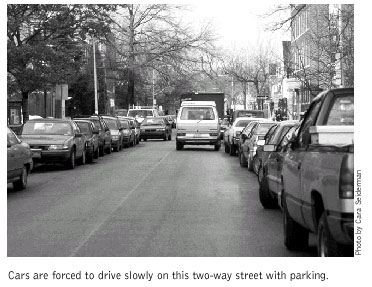13. One-Way/Two-Way Street Conversions
One-way streets can simplify crossings for pedestrians, who must look for traffic in only one direction. While studies have shown that con-version of two-way streets to one-way generally reduces pedestrian crashes, one-way streets tend to have higher speeds which creates new problems. If a street is converted to one-way, it should be evaluated to see if additional changes should be made, especially if the street or lanes are overly wide. Also, traffic circulation in the broader area must be carefully considered before conversion to one-way streets.
As a system, one-way streets can increase travel distances of motorists and create some confusion, especially for non-local residents. One-way streets operate best in "pairs," separated by a block to no more than one-quarter mile. Conversion costs can be quite high to build "crossovers" where the one-way streets convert back to two-way streets, and to rebuild traffic signals and revise striping, signing and parking meters.
One-way streets work best in downtown or very heavily congested areas. One-way streets can offer improved signal timing and accommodate odd-spaced signals, but signal timing for arterials that cross a one-way street pair is difficult.
Conversions can go the other way as well:
some places are returning one-way streets back to two-way to allow better
local access and to slow traffic. Two-way streets tend to be slower due
to "friction," especially on residential streets without a marked
center line. 
Purpose:
- Managing traffic patterns.
- Reducing conflicts.
- A one-way to two-way conversion will generally reduce speeds.
Considerations:
- Consider impacts on other streets.
- Be careful not to create speeding problems where a two-way is changed to a one-way. Redesign or traffic calming measures may be required to address this.
Estimated Cost:
$20,000-$200,000 depending on length of treatment and if the conversion requires modification to signals.